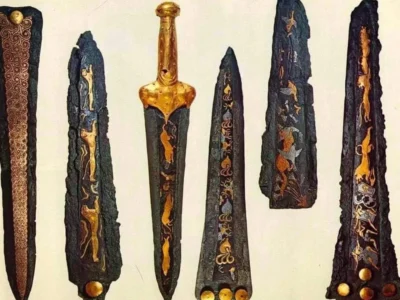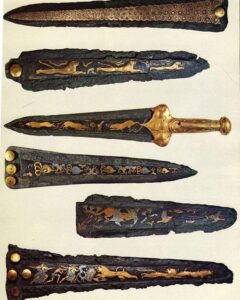Mycenaean Daggers Found in Crete’s Grave Circle A (1550–1500 BC)

In a riveting archaeological revelation, a collection of Mycenaean daggers, crafted from silver and gold, has been unearthed from shaft graves 4-7 in Grave Circle A on the island of Crete, Greece. Dating back to 1550-1500 BC, these exquisite artifacts provide an entrancing portal into an era of opulence and craftsmanship. This remarkable discovery has set the archaeological community ablaze with insights into the Mycenaean civilization’s affluence, skill, and cultural tapestry.

The Mycenaean daggers, shimmering in silver and gold, represent an unparalleled level of craftsmanship and artistic skill. These blades, discovered within shaft graves 4-7 of Grave Circle A, offer a glimpse into the luxury and artistry that characterized the Mycenaean culture. Made from these precious metals, the daggers were not only functional tools but also symbols of status and power.
Experts have been captivated by the intricate details of the daggers’ design. The melding of silver and gold allowed for a stunning interplay of light and shadow, creating a visual spectacle that undoubtedly garnered the admiration of contemporaries. The precision in crafting the blades with such precious materials speaks volumes about the Mycenaean artisans’ mastery over metallurgy and their dedication to creating items of aesthetic and utilitarian value.

The Mycenaean daggers were discovered within the confines of Grave Circle A, an archaeological treasure trove that has long held the secrets of the Mycenaean civilization. The shaft graves within this circle have yielded an array of artifacts, including pottery, jewelry, and weaponry, painting a vivid picture of the culture’s material opulence and social hierarchies.
Grave Circle A, situated in Crete, Greece, serves as a silent testament to the sophisticated rituals and practices of the Mycenaean people. The presence of the Mycenaean daggers in this burial site indicates their significance in both life and death. These daggers might have symbolized the transition between mortal existence and the afterlife, underscoring the culture’s beliefs in the connection between the physical and spiritual realms.
Beyond their inherent beauty, the Mycenaean daggers offer insights into the society’s power dynamics and hierarchy. During the Mycenaean period, weapons like these daggers often doubled as symbols of authority. Their opulent construction conveyed the wielder’s prestige, authority, and control.
As experts delve into the context of Grave Circle A and the broader Mycenaean society, they uncover the stories of those interred with these luxurious artifacts. The presence of the daggers alongside other valuables indicates that the individuals laid to rest were likely members of the elite, serving as a poignant reminder of the inequalities that marked this ancient civilization.
Cultural Threads Woven: Echoes of Mycenaean Life
The discovery of the Mycenaean daggers resonates with the larger tapestry of the civilization’s life and culture. The Mycenaean period, known for its grand palaces, intricate frescoes, and monumental tombs, reflects a society that was both militaristic and prosperous. These daggers, with their precious materials and exceptional craftsmanship, embody the Mycenaean’s penchant for extravagance and artistic expression.
Archaeological finds like these daggers contribute to our understanding of the Mycenaean culture’s interplay between aesthetics, symbolism, and function. Their presence in burial contexts underscores the cultural significance of death rites and the belief in an afterlife, revealing the complex relationship that the Mycenaean people maintained with the spiritual realm.
The unearthing of the Mycenaean daggers presents both opportunities and challenges for the field of archaeology. As researchers strive to unlock the mysteries held within these artifacts, careful preservation becomes paramount. Analyzing the materials, craftsmanship, and historical context requires a delicate balance between scientific investigation and the preservation of the daggers’ integrity.
The discovery of the Mycenaean daggers from 1550-1500 BC in Crete’s Grave Circle A opens a window into an age of opulence and grandeur. Crafted from silver and gold, these blades showcase the artistic prowess and cultural values of the Mycenaean civilization. As experts continue to delve into the significance of these artifacts, they bring to life a bygone era where precious materials and intricate craftsmanship intersected to create enduring symbols of power and prestige.